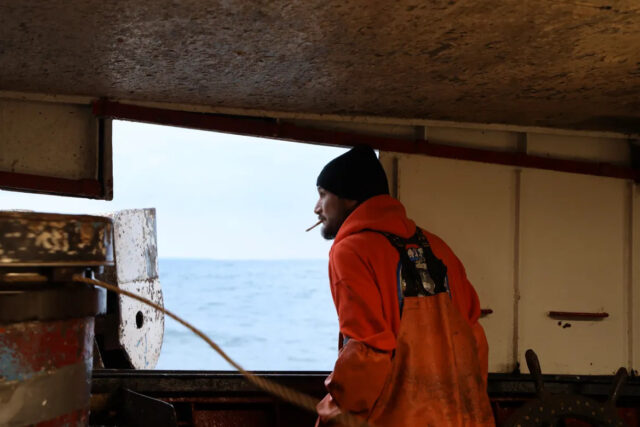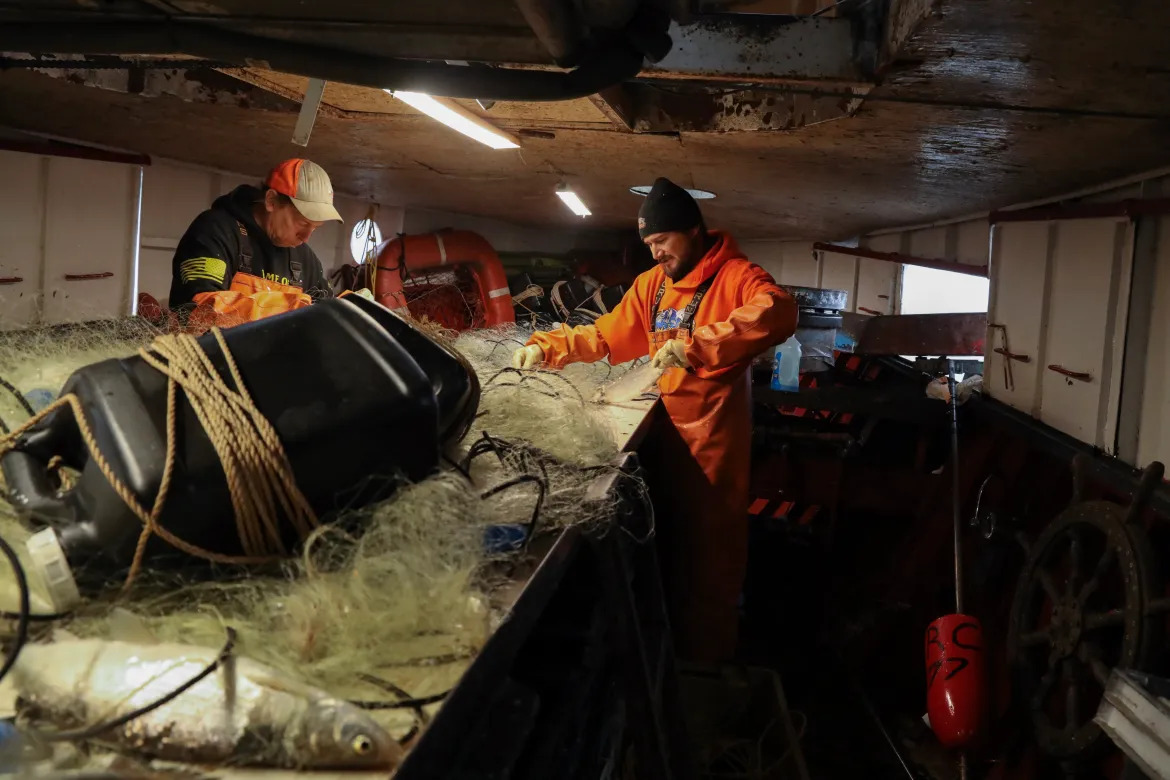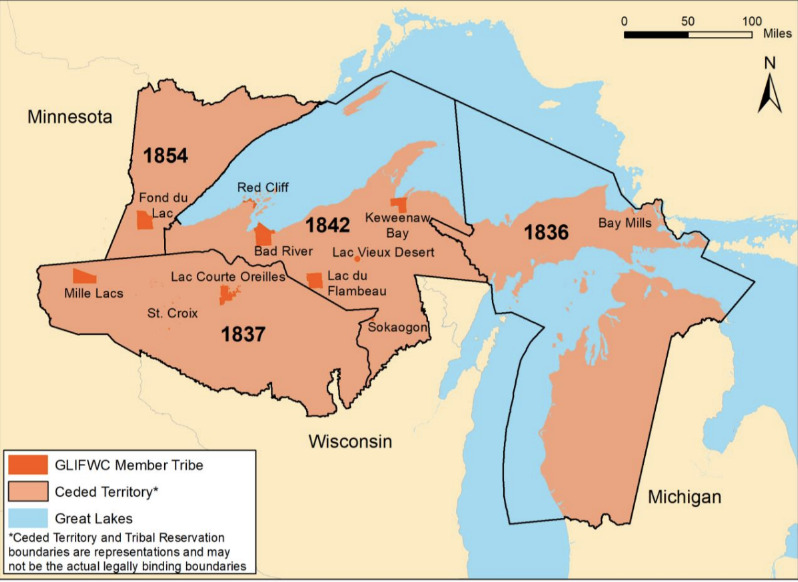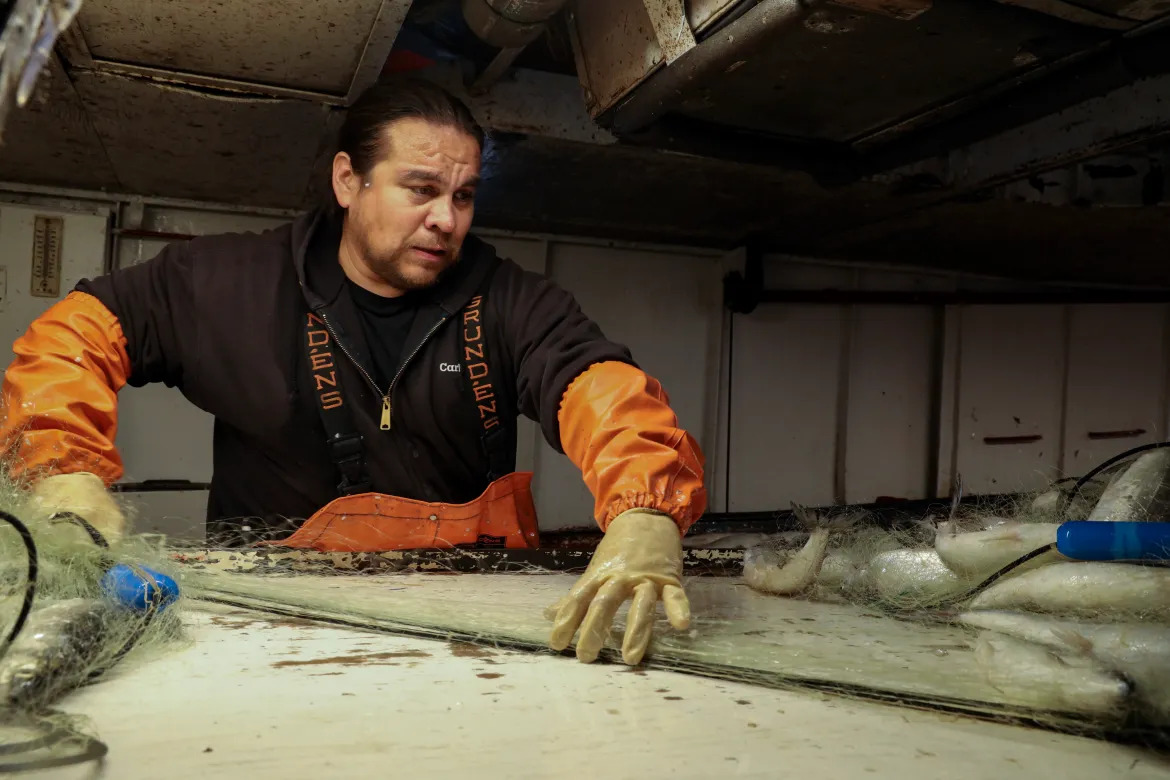
By Bennet Goldstein
Wisconsin Watch
The ensnared fish seemed to materialize from the opaque water. Thrashing, wriggling, they rose, enfolded by mesh.
The lift reeled in the gillnet into the arms of a waiting crew, who hoisted it atop a table. Lake herring flopped weakly as the men gripped and untangled them from rope and nylon fiber. Iridescent scales popped into the air like confetti.
“When the floor is shiny with scales, we know we are making money,” said commercial fisherman Donny Livingston, grinning widely.
Shortly before dawn, the fish tug, Ava June, pulled out from Duffy’s Dock, on the tip of northern Wisconsin’s Bayfield Peninsula. The vessel churned through Lake Superior’s chilly waters for 2 1/2 hours.
Waves slapped the boat after it left the shelter of the Apostle Islands near the main shipping channel. Snow drifted from the cloud-choked November sky. The fishermen finally reached the nets they set the previous day.
Livingston is a citizen of the Red Cliff Band of Lake Superior Chippewa, one of six federally recognized Ojibwe tribes in Wisconsin. His family has fished for generations and holds one of the original licenses issued to Red Cliff tribal citizens.
But Livingston’s access to Lake Superior fish was never a foregone conclusion.
Ojibwe, Ottawa and Potawatomi communities, who also call themselves Anishinaabe, have fished in the Great Lakes for centuries. But in the mid-1800s, the federal government, desiring to open the Wisconsin Territory to lumbering and mining, forcibly acquired Ojibwe lands and waters through a succession of treaties.
The bands retained hunting, gathering and fishing rights across what’s now called the Ceded Territory: portions of three Great Lakes and millions of acres stretching across northwestern Michigan and its Upper Peninsula, northern Wisconsin and northeastern Minnesota. The final treaty established reservations for four of the Wisconsin Ojibwe tribes.
States spent a century disregarding or rejecting treaty rights — fining or arresting tribal citizens who exercised them. After several citizens sued, a series of court rulings, starting in 1971, would affirm their reserved rights within the Ceded Territory, including the right to fish on Lake Superior.
But many see toxic pollution in the Great Lakes as a continued encroachment on how Ojibwe communities exercise those rights.
Alongside mercury, a neurotoxin that can harm the brains and nervous systems of developing fetuses, and carcinogenic polychlorinated biphenyls (PCBs), are the latest contaminants of concern — per- and polyfluoroalkyl substances, or PFAS.
The “forever chemicals” are a class of more than 12,000 compounds that accumulate in the environment and human bodies. Scientists link two of the most widely researched — PFOA and PFOS — to a range of health problems, including cancer.
The failure of state and federal governments to keep contaminants out of the environment, scholars and environmental advocates say, calls into question their commitment to fully protect Indigenous rights.
“It’s a modern way of denying access and destroying foodways,” said Katrina Phillips, an associate professor of history at Macalester College and a Red Cliff citizen. “It’s through chemicals and pollutants instead of treaties and court cases.”
Tribes aim to fill regulatory vacuums through their own natural resources department projects, input on cross-government management committees and litigation. Now, those efforts may get support from a U.S. Environmental Protection Agency proposal that elevates consideration of treaty rights when states set water quality regulations.

Fish are vital for Ojibwe communities
Livingston, 42, supposes he is one of the youngest commercial fishers in Red Cliff.
The work is grueling. Profit margins, narrow. Crew, tough to find.
When he’s not out fishing, Livingston stays busy mending nets.
“It ain’t a 9 to 5,” he said during the November fishing trip, “I’ll tell ya’ that.”
Livingston tried other careers but always returned to fishing.
“It’s something I know how to do,” he said. “It’s something I can depend on.”
Livingston and his three-member crew worked a nearly 12-hour shift on Lake Superior, or Anishinaabe Gitchigami in the Ojibwe language.
The Red Cliff Reservation flanks the lake’s southern coastline, marked by blazing sandstone cliffs, wetland sloughs and rivers.
Coyotes and bobcats roam its 15,000-plus acres. Whitetail deer bound through rolling forests, dense with conifers and hardwoods. Bald eagles soar overhead, and ospreys dive to prey on fish.
These relatives — the plants and animals, the land and water — sustain Ojibwe communities, as Chief Flat Mouth, of the Pillager band from Leech Lake in Minnesota, articulated in 1837 while negotiating one of the treaties. He questioned the fairness of the federal government’s proposed compensation for taking control of Ojibwe territory.
“You know that without the lands, and the rivers and lakes, we could not live,” the chief told government officials. “We hunt and make sugar and dig roots upon the former, while we fish and obtain rice and drink from the latter.”
Giigoonh, or fish, are important for subsistence, culture and business. But climate change threatens many species, and contaminants long released into the Great Lakes, the health of people who eat them.
“The community getting impacted by something in the environment, that’s something that has been happening to us from day one of European onset,” said Edith Leoso, retired tribal historic preservation officer with the Bad River Band of Lake Superior Chippewa.

A Great Lake for fishing
Livingston and his business partner, Bryan Bainbridge, grew up in and around Red Cliff.
More than 7,600 people are living tribal citizens, about 16% of whom live on the reservation. A few hundred reside just 3 miles south in Bayfield, a destination for lake-loving tourists.
The tribe is the largest employer in the county, providing jobs to about 300 people — many in tribal administration and the Legendary Waters Resort and Casino.
But at its heart, Red Cliff is a fishing community.
“That’s what everybody’s family has done around here,” said Bainbridge, 45, a former Red Cliff tribal chairman. “I grew up on fish.”
Bluegills, perch, suckers — a fish every day, whatever they caught.
Livingston and Bainbridge teamed up about a decade ago shortly before Bainbridge acquired the tug from an old fisherman in Kenosha, Wisconsin.
Constructed in the mid-1940s by the Burger Boat Company in Manitowoc, Wisconsin, the diesel-powered boat measures nearly 50 feet from bow to stern. Bainbridge christened it the Ava June.
“My niece had a little baby that died just before I got the boat,” Bainbridge said, “so when I got back here, we named it.”
In their day-to-day business operations, Bainbridge handles the duo’s paperwork. Livingston does most of the captaining. “He can catch fish like no one else,” Bainbridge said.
With SiriusXM radio blasting during the November fishing run, the crew worked quietly, tossing freshly caught fish into stacked plastic boxes. They laughed whenever one chucked a herring at the other.
That day, they sold their catch to the Red Cliff Fish Company, a tribally owned fish processor and seller, but they also distribute fish to markets as far away as New York.
After decades of overfishing from the late-1800s through the 1930s and the introduction of invasive species, Lake Superior’s fish populations have rebounded enough to sustain a consumer
market. Among tribally licensed commercial fishermen, whitefish, salmon, lake trout, trout and lake herring constitute the bulk of the catch.
The combined commercial fish harvest of 11 Ojibwe nations that are members of the Great Lakes Indian Fish and Wildlife Commission, an inter-tribal natural resource management organization that helps oversee the implementation of off-reservation treaty rights, annually exceeds 2 million pounds.

PFAS in Great Lakes water and fish
For much of the 20th century, manufacturing plants generated mercury- and PCB-containing wastes and dumped them directly into the Great Lakes or its watershed. Power plants and incinerators also spewed air pollution that tainted waters, and they continue to do so.
Their concentrations have declined significantly in Great Lakes waters since the 1970s due to efforts of the U.S. and Canadian governments, states and industry to reduce toxic emissions. Yet lingering mercury and PCBs bioaccumulate in animals at levels high enough to warrant fish consumption advisories.
PFAS also are drawing greater scrutiny as their harms come into focus. In 2021, the Wisconsin Department of Natural Resources issued Lake Superior’s first PFOS advisory, warning against eating too many smelt.
PFAS, which are added to products ranging from fabric stain protectors to firefighting foam to food packaging, enter water bodies through wastewater, airport and fire training runoff and the atmosphere.
“You find these chemicals everywhere,” said Christy Remucal, an associate professor of civil engineering at the University of Wisconsin-Madison who studies PFAS contamination in the Great Lakes. “I don’t think we’ve ever not measured them in a water sample.”
Researchers have yet to develop effective methods for destroying PFAS at scale, and Lake Superior’s gargantuan proportions would make doing so impossible.
Compared to the other Great Lakes, the concentration of PFAS in Lake Superior water is lower due to less development within its watershed. But virtually no amount of PFOA and PFOS is safe for human consumption, according to the EPA, which in 2022 updated draft health advisories for the two chemicals.
A recent study from Duke University and Environmental Working Group researchers found large
concentrations of PFOS in freshwater fish sampled nationwide by the EPA from 2013 to 2015, with the highest levels found in the Great Lakes.
If all consumption advisories incorporated the EPA’s latest health guidance, the study found, nearly all sampled fish would be “considered unsafe to eat.”
The impacts of such pollution and climate change create “an elevated level of environmental anxiety” in Ojibwe communities, said Dylan Bizhikiins Jennings, associate director of Northland College’s Sigurd Olson Environmental Institute and a former Bad River tribal council member.
“Once these things go away, they don’t come back,” Jennings said. “It’s about our life.”
Anishinaabe cultures embedded in places
Leoso, the former Bad River tribal historic preservation officer, grew up on the reservation in her grandparents’ house near the Kakagon River.
Her grandmother grew angry when children threw things into the water to watch them wander with the seiche. She told them never to spit into the river.
“It was putting the thought into my mind: should I spit in the river?” Leoso said. “Would I like to be spit on?”
One day, Leoso’s grandmother decided to teach the young girl to pray for the water by placing tobacco into it. Leoso, then about 8 years old, had been raised Catholic.
“Don’t do anything disrespectful on this water or to this water,” her grandmother told her. “Because it’ll take care of you, and everything you need is here.”
Indigenous origin stories, histories, languages and cultures are embedded in the land, said Phillips, the historian.
“For Ojibwe people in northern Wisconsin, Lake Superior and the northern part of Wisconsin with Red Cliff and Bad River, these places define who we are,” she said.
The Anishinaabe migration story, which recounts the journey from the East Coast to the Great Lakes, is just as much about place as it is people; and those places and the beings living there are considered precious.
While Biblical cosmology frames mankind as “masters over the fish in the ocean, the birds that fly, the livestock, everything that crawls on the earth and over the earth itself,” Ojibwe communities invert that pyramid, said Mike Wiggins Jr., Bad River tribal chairman.
“Human beings, we as people, are the most pitiful,” he told listeners during a Wisconsin Historical Society storytelling event. “Without Mother Nature, we go away. Without human beings, Mother Nature thrives. And so, there’s some humility to that.”
In accordance with their bimaadiziwin, or traditional lifeway, Ojibwe people harvest from nature — things like wild rice, deer, maple sap and fish — as an act of stewardship. If they do not, the Creator will cease to provide those beings.
When the land and water are contaminated, future generations lose knowledge and stories centered on fishing and other harvesting. Family, kinship, oral history, ceremony, community cohesion, food security and self-determination suffer.
“Everything that makes us Native,” said Patty Loew, director of the Center for Native American and Indigenous Research at Northwestern University and a Bad River citizen.
“If the health of the fish or the wild rice is compromised,” she said, “then treaty rights are meaningless.”
Great Lakes cleanups see mixed outcomes
U.S. and Canadian governments have achieved some successes in improving the health of the Great Lakes and its fish since 1972. That’s when the countries signed the Great Lakes Water Quality Agreement, which aims to coordinate Canadian and U.S. lake restoration efforts. Yet, neither country is required to abide by the agreement, which is periodically updated, and the International Joint Commission, formed by the binational Boundary Waters Treaty in 1909, issues recommendations to both parties but lacks authority to compel action.
The non-regulatory Great Lakes Restoration Initiative supports the agreement through funding and goal-setting. Key aims include restoring some of the most polluted “areas of concern” along the lakes.
In a 2022 progress report, the EPA and its Canadian counterpart praised “unprecedented progress” toward that goal. The countries have so far delisted nine of 43 sites.
However, both countries have failed to meet a 1990 International Joint Commission challenge to eliminate the release of nine toxic pollutants into the Lake Superior Basin.
The lack of a final deadline or requirement that the countries launch new initiatives stymied the effort, scholars say.
In 1999, the program selected 2020 as the year to achieve “virtual elimination” of the pollutants. Neither country has banned toxic discharges, enabling them to continue.
In their 2022 assessment, the countries rated the status of toxic chemicals in Lake Superior’s fish as “fair and unchanging” — not yet safe to consume without restrictions.
EPA proposal: regulations must consider treaty rights
The 20th-century court rulings in Wisconsin that affirmed treaty rights addressed whether, where and how Ojibwe tribes could exercise them and the regulations deemed necessary to ensure the “supply” of natural resources would be maintained. But courts did not consider the quality of plant and animal habitats.
“It’s a legally gray area, how far the tribes can dictate what a state or the federal government might have to do or not do in order to preserve the treaty rights,” said Ann McCammon Soltis, director of the division of intergovernmental affairs at the Great Lakes Indian Fish and Wildlife Commission.
But GLIFWC’s member tribes believe states should preserve the integrity of natural resources, she said.
A recent EPA proposal could address some of those concerns.
The draft rule would require states to account for treaty rights, such as fishing and wild rice gathering, when adopting water quality standards under the Clean Water Act. That law forces states, territories and some tribal governments to improve the quality of water bodies within their borders when they cannot safely be utilized for designated purposes, such as drinking or recreation.
States would also need to preserve full use of any resources guaranteed under the treaties on and off reservations. The EPA is accepting public comment on the draft rule until March 6.
Wisconsin DNR officials said the agency already consults with affected tribes and considers their uses of a waterbody when it sets water quality standards. Tribes also may submit comments when states review their standards every three years.
But “the states haven’t really had to respond in any way” when the tribe presents a request, Soltis said.
“This indicates that the EPA is going to be a little bit more willing to take what the tribes say seriously in that context and ensure that the state is responding.”
Red Cliff band protects sovereignty
Absent stronger state and federal action, Ojibwe communities have forged strategies to protect water, fisheries and lifeways now and for the next seven generations.
“Our reservation is booming and our people, more and more people, are coming home,” Bainbridge said of Red Cliff. “We want to make sure that we maintain the integrity of what we’ve been allowed to harvest and what’s been provided for us.”
To that end, Red Cliff’s Treaty Natural Resources Division oversees the protection and enhancement of natural resources within the reservation boundaries and the band’s ceded territory. That includes stream and riverbank restoration, water and air quality monitoring, hazardous waste disposal and wild rice reseeding. An environmental justice specialist monitors outside projects including mines, pipelines and concentrated animal feeding operations that could affect treaty rights.
The tribe bolsters food sovereignty through its Red Cliff Fish Company, which opened in 2020, and 35-acre Mino Bimaadiziiwin Gitigaanin — Return to the Good Life Farm.
Red Cliff Tribal Fish Hatchery staff raise brook trout in hopes of restoring populations to past levels in Lake Superior. They also rear walleye in ponds to increase populations in inland lakes.
Practicing treaty rights might be viewed as a political act in a country with a long history of challenging them.
“Having to fight for access to food is kind of mind-boggling in a sense,” Phillips said. “Advocating for the right to feed your people is somehow seen as resistance or activism.”
This story is a product of the Mississippi River Basin Ag & Water Desk, an editorially independent reporting network based at the University of Missouri School of Journalism in partnership with Report For America and funded by the Walton Family Foundation. Wisconsin Watch is a member of the network. Sign up for our newsletter and donate to support our fact-checked journalism.



























